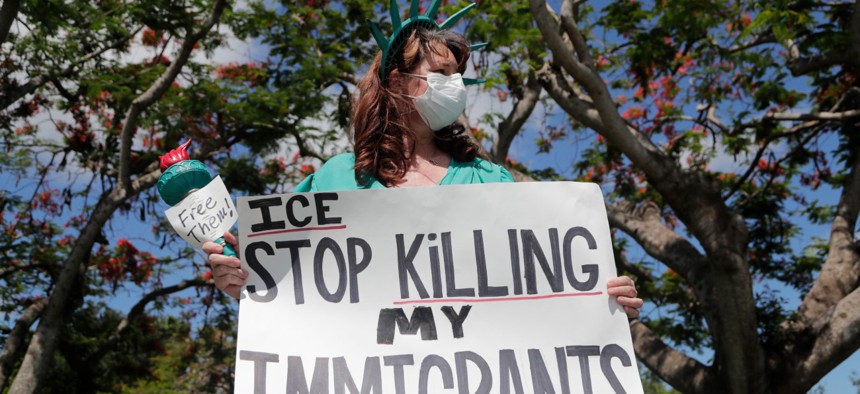ICE Struggles to Protect Detained Immigrants as Coronavirus Spreads in Its Facilities
Hundreds of employees are also calling out from work as they say physical distancing is impossible and personal protective equipment is in insufficient supply.
Immigrants held in federal detention have inadequate access to equipment and supplies to protect them from the spread of the novel coronavirus, according to a new report and accounts from inside the federal facilities, and those who have tested positive for COVID-19 are not being quarantined or isolated from the rest of the population.
Cases among the detained population at Immigration and Customs Enforcement have skyrocketed in recent weeks, spiking by nearly 500% from late April to late May. There are now nearly 2,500 cases, according to the most recent figures from ICE, and two immigrants have died.
In surveying employees at detention facilities around the country, the Homeland Security Department's inspector general found ICE was failing to implement physical distancing to prevent the spread of the virus. The agency generally keeps 50-75 detainees in each “pod” in its facilities, creating “unique challenges for detention centers to mitigate the risk of infection and transmission of COVID-19,” the IG said. As a result, ICE did not always separate those who were symptomatic or had tested positive from the rest of the population.
“The major challenges [sic] is having enough places to properly quarantine detainees,” one ICE officer told the IG. “Six of the dorms are open and do not have individual cells.”
The IG did not speak to detainees or visit sites personally. The investigators said their work was ongoing and a “more comprehensive” report would follow.
Testing also appears lacking at ICE facilities. As of May 26, when the IG last recorded data, more than 50% of detainee tests came back positive for COVID-19. That has since improved, but the positive rate is still at 28%, well above the national average. ICE officials told lawmakers at a hearing earlier this month the agency would begin testing immigrants as they entered facilities. Most ICE facilities only for migrant detainees could test on-site, while only slightly more than half of facilities that had a mix of detainees and inmates could do so. One-in-five of those mixed facilities had no testing at all, the IG found.
The detainee population at ICE has decreased by 27% since April 1, in part due to the agency intentionally releasing some immigrants and court orders to let others go. Not all facilities had implemented ICE’s agency-wide guidance in dealing with the pandemic, with just 83% of facilities ever receiving it.
The agency is taking precautions for staffing shortfalls, as 850 employees at the facilities the IG reviewed had either gotten sick themselves or were forced to stay home on quarantine. Forty-five ICE employees have tested positive for COVID-19. Officials told the IG they had contingencies in place for reduced staffing levels, including longer shifts and requesting staff from other facilities.
Despite ICE's failures, employees overwhelmingly told the IG their facilities were adequately prepared for the pandemic. They had conducted risk assessments for potential exposure and 90% said they had enough masks. One-third of facilities, however, reported having insufficient hand sanitizer for detainees.
ICE Chief Financial Officer Stephen Roncone classified the report as “overwhelmingly positive,” saying he was pleased with the IG's "positive recognition" of the steps the agency has taken to prevent the spread of the virus. Roncone noted the IG did not make any recommendations nor did it independently verify the responses it received from its survey. He also criticized the auditors for limiting "the usefulness of the report" by failing to disclose the specific facilities at which "possible opportunities to improve the effectiveness and efficiency of ICE operations" exist.
“Although ICE law enforcement officers and agents continue to fulfill ICE's enforcement mission by prioritizing enforcement action against those individuals who threaten national security and public safety, ICE is firmly committed to ensure the health and safety of individuals in its custody, its employees, contractors and the general public,” Roncone said.
While the IG did not talk to detainees as part of its review, the Miami Herald on Tuesday reported on court documents in which ICE officials conceded that the migrants at multiple facilities in south Florida had sought to sound the alarm about individuals who have tested positive for COVID-19 being mixed in with the rest of the population. The detainees said they did not have sufficient access to masks, soap or sanitizer, and there was no social distancing taking place.
ICE told the court it had freed up more money to purchase additional supplies. Earlier this month, U.S. District Judge Marcia Cooke ordered ICE to stop placing COVID-19 positive detainees in the same areas as healthy individuals. The detainees wrote letters to the court complaining of poor conditions, a lack of safety protocols and an inability to get in touch with deportation officers who were instructed to stay away from facilities during the pandemic.
Also on Tuesday, a group of several immigration advocacy groups and immigrants currently detained spoke to the media about contract ICE facilities run by GEO and using toxic chemical disinfectants. The sprays deploy harmful chemicals that cause dangerous side effects, the groups and individuals said, such as frequent nose bleeding and respiratory distress. They, too, decried unsafe conditions related to the lack of personal protective equipment and the intermingling of positive and non-positive detainees.




